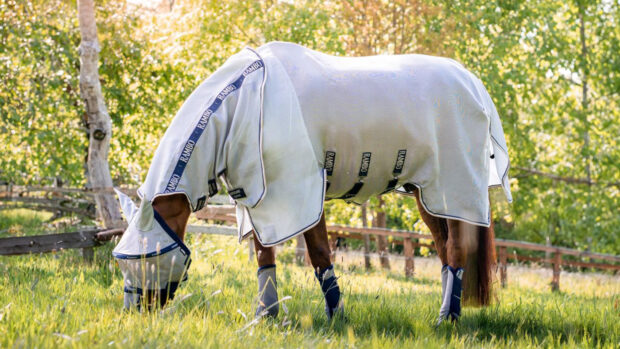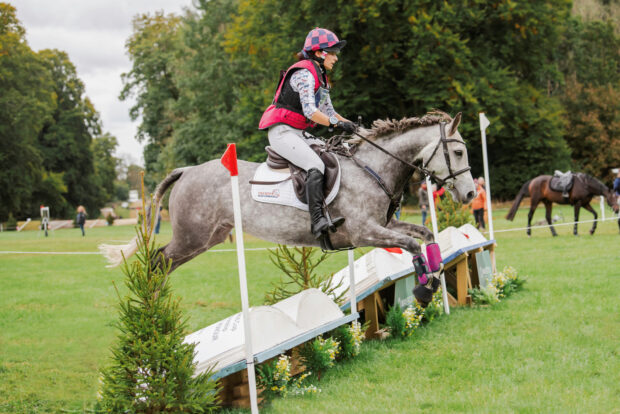There is a bewildering array of types of horse boots on the market, but the choice is straightforward once you identify what you need, and your budget. Most horse boots are designed to protect your horse’s legs from injury during riding, lungeing or turnout. They provide a layer of protection from injury, damage and trauma if the horse should knock his legs or have a propensity to overreach or strike into himself, as well as absorb some impact shock from the horse’s hoof landing on the ground.
Horse boots are designed to be used in pairs, fore and hind, and some people will use just one pair – or none at all, depending on the activity and needs of the horse. Hind boots tend to be longer, and may be shaped specifically for the hindleg – such as fetlock boots. Occasionally, you might use a single boot – for example a pastern ring.
Boots are made from a variety of materials – neoprene, plastic, sheepskin, leather, for example – and with a range of fastenings. The closures are fastened on the outside of the leg, to prevent them being knocked and coming undone.
The horse’s conformation, movement and discipline will all affect whether he needs boots and which type.
Most common types of horse boots

Brushing boots
These are everyday boots designed to protect the lower part of the horse’s legs from any damage due to the opposite hoof “brushing” or knocking the leg and external knocks, while also protecting the splint bone. They are versatile – used for training, flatwork, lungeing, hacking or turnout – and can be used on fore and hindlegs.
Generally, brushing boots are made from a soft fabric, such as neoprene, which contours to the shape of a horse’s leg, and may be reinforced with PVC on the inner leg. They come in various designs and price points depending on the material and technology.
Some riders prefer to use polo wraps for everyday training, but boots are a time-saving alternative. They are not permitted in a dressage test, but may be worn for warming up.
Speedicut boots are a style of brushing boot that covers further up the inside of the horse’s hind legs, which are typically used for horses that catch themselves in this area while doing fast work.
- Check out our selection of the best brushing boots

Tendon and fetlock boots
Tendon boots go on the forelegs, fetlock boots (which are sometimes known as ankle boots) on the hinds.
Tendon boots are designed with showjumpers’ needs in mind as they are similar to a brushing boot in providing protection the inner leg, tendons and fetlocks from knocks, but are open-fronted to allow the horse to feel when he touches a pole. They are often further reinforced to protect against more serious strikes into the tendons as they are designed for jumping.
Fetlock boots just protect the fetlock joint from brushing injuries while leaving the front of the leg exposed. They are made from a variety of flexible yet shockproof materials, and many designs have ventilating properties.
- Check out our selection of the best tendon and fetlock boots

Overreach/bell boots
These surround the hoof and heels to protect from over-reaches and strikes – they are sometimes called bell boots because of their shape. Over-reaching is when the hind hoof cuts into the front. Some horses have a natural propensity to move like this, while the impact is more serious in the faster paces, so they are commonly used across country. Overreach boots are used for training, flatwork, lungeing, hacking, turnout, competition (not dressage) and so on. They tend to be made from neoprene or rubber, sometimes with a fleece trim to prevent rubbing around the pastern.
- Check out our selection of the best overreach boots

Cross-country boots
These are similar in shape to brushing boots, but are specifically designed to protect your horse from the extra risk of jumping across country. As such they offer a higher level of protection, while not interfering in any way with his movement. They are made from a strong, lightweight material, with reinforcement such as strike guards to provide extra protection.
They are designed not to absorb water, so the horse isn’t weighed down after jumping into the water fence. They come in a range of technical specification (and are priced accordingly) – some have an air cooling system, with vents to allow cold air to pass through the boot and over the tendons, keeping them cool.
- Check out our selection of the best cross-country boots

Travelling boots
These offer protection for a large part of the horse’s leg from any impact during travelling. The front boots will cover the knee down to the hoof, while the back boots are shaped to cover the hock and again down to the hoof, and are made of shockproof but lightweight materials. They are usually made in a wrap-around style with velcro straps on the outside of the leg. Look for a tough outer shell with a soft inside material for maximum comfort on a long journey. It’s also advisable to try a few styles to make sure the horse is comfortable as they are anatomically shaped.
Some horses take a dislike to having their full leg restricted in this way, so it is important to expose him gradually to the boot before loading him into the horsebox.
- Check out our selection of the best travelling boots
Other types of horse boots
Ring boot
This is also called a fetlock or pastern ring, and is a rubber ring designed to be worn below the fetlock to offer protection to the pastern and coronet band. It’s useful for horses with close movement low down, which can cause shod hooves to brush the opposite side. It can be worn for schooling or turnout.
A sausage boot is similar in style but is much bigger and designed to protect the stabled horses from capped elbows when lying down.
Knee boot
Knee boots used to be a common sight, particularly on racehorses working on the road, but have largely gone out of fashion. Some people still insist on using them, not because their horse trips, but because there is always a risk of slipping on a bad surface and skinning the knee. Traditionally knee boots are made of leather or suede, but now with more modern materials, and are strapped over the knee for road work and travelling.
Therapy boots
An added bonus in your tack room to help a horse heal from injuries or recover from strenuous activity. Magnetic boots increase blood flow in the horse’s leg (and therefore healing), while ice or cooling boots help to cool the legs quickly after a workout to help prevent injury. Some boots use bio-ceramic technology to promote healing.
Hoof boots
These are designed for barefoot horses who need additional protection to cross certain terrain, or when a horse has lost a shoe. There are also types for horses undergoing rehab or suffering from lower limb or hoof problems such as laminitis or abscesses.
- Check out our selection of the best hoof boots
How to estimate your horse’s boot size
Most types of horse boots are available in small, medium and large sizes, and a few manufacturers produce boots that are scaled to fit ponies and extra-large horses. Some brands also make wide versions of some sizes. Most manufacturers provide sizing charts with their product packaging.
In general, the height, weight and breed of your horse in combination with the circumference of its leg, will provide you with an estimation of the appropriate boot size to try on your horse.
If you have a small horse with refined bones, perhaps a large pony or Arab that weighs less than 500kg, you’ll probably need small-sized horse boots. Many horses require a smaller size boot on their front limbs and one size larger boot on their hind limbs.
Most thoroughbreds of average bone and an average height of about 16hh will require medium boots, while warmbloods and sport type horses may need large or even extra-large boots.
How to check the fit of horse boots
You should be able to slide one finger between the protective boot and the horse’s leg. Your finger should feel snug between the two surfaces. If the boot is too big or too loose, dirt can get inside and cause abrasions or slide downward where it may disrupt the horse’s movement. If the boot is too tight, it can damage the horse’s tendons.
The length of a boot on your horse’s leg should be checked as well. You don’t want the boot to be so long that it rises to the back of the knee and interferes with normal movement. It should, however, be long enough to cover most of the cannon bone area as well as the inside of the fetlock.
Tips:
- When fastening different types of horse boots, be sure to use even pressure on each strap as you work your way down the leg. Follow the manufacturer’s instructions carefully for your type of boots, and be careful not to over-tighten them.
- Remove boots from your horse’s legs as soon as possible after your workout to allow any accumulated heat to escape and to allow the skin and hair to dry.
- Keep the boots clean and free of accumulated dirt, grime, and sweat, which can be irritating to a horse’s sensitive skin.
You may also like to read…

Brushing boots for all budgets

12 pairs of boots ready to go out on the cross-country course

11 pairs of overreach boots that will help to protect your horse

Geoff Billington’s secret weapon: overreach boots on hind legs
Why would you put over reach boots on hind legs? Geoff Billington uses this simple solution to a testing problem

Subscribe to Horse & Hound magazine today – and enjoy unlimited website access all year round
Horse & Hound magazine, out every Thursday, is packed with all the latest news and reports, as well as interviews, specials, nostalgia, vet and training advice. Find how you can enjoy the magazine delivered to your door every week, plus options to upgrade your subscription to access our online service that brings you breaking news and reports as well as other benefits.




